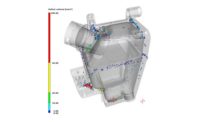NDT - Computed Tomography
Industrial Computed Tomography
Learn more about this effective technique.

 Computed tomography is a great advent to the manufacturing, testing and measurement of aluminum die-cast parts. Source: Wenzel |
Using the most advanced technology available in the fields of production and quality as-surance, parts can be machined and measured with the highest levels of accuracy by manu-facturing companies. By employing the newest and most progressive volume-scanning technology in the industry, manufacturers can produce and test aluminum die-cast parts that are be both extremely functional and effective.
One of the most important steps in this process is testing and analyzing porosity. Pores are generally categorized with color coding according to their size. When conventional test-ing methods are used, parts must be destroyed. However, by utilizing industrial computed tomography, parts can be tested in 3-D and without destruction. This technology has com-pletely changed the way in which parts are tested and allowed for highly increased levels of productivity. Computed tomography is a great advent to the manufacturing, testing and measurement of aluminum die-cast parts.
Proprietary detector technology enables manufacturers to achieve both a high spatial resolution and a high contrast resolution. With these advanced methods, even miniscule pores and clusters of pores can be detected and evaluated. Since computed tomography re-places the previous destructive methods that were used in testing and measurement, parts are still fully functional after the procedure is completed. Knowledge gained during this process is used for further casting, and to minimize porosity.
There is specific measuring software available that is used for dimensional evaluation of parts. Surface data that is collected by industrial computer tomography is used in the prob-ing of measurement points. By incorporating this method, manufacturers can dimensionally measure and evaluate internal structures that cannot be assessed by tactical or optical strate-gies. Computed tomography technology has proven to be extremely effective and has great potential for the analysis of material integrity and dimensional accuracy.
Looking for a reprint of this article?
From high-res PDFs to custom plaques, order your copy today!




